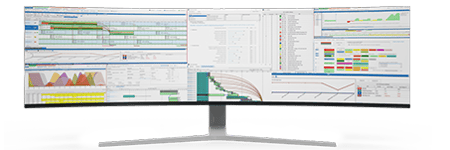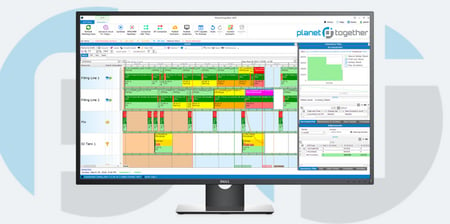Optimizing Materials Planning in Pharmaceutical Manufacturing
The pressure to maintain production efficiency, ensure compliance, and meet rising demands is constant. Production planners play a pivotal role, balancing material availability with production schedules to ensure seamless manufacturing processes. Materials planning, in particular, is a critical aspect where the stakes are high—any delay or shortfall can disrupt entire production lines, impacting delivery timelines and, ultimately, patient access to vital medications.
With advancements in technology, materials planning has evolved from isolated processes to integrated systems that bring together data from multiple departments and external suppliers. Integrating Advanced Planning and Scheduling (APS) tools like PlanetTogether with robust ERP systems such as SAP, Oracle, Microsoft, Kinaxis, and Aveva has proven transformative. This synergy equips pharmaceutical production planners with the agility and precision needed to navigate complex supply chains, improve inventory control, and make data-driven decisions.
In this blog, we’ll look into the key aspects of materials planning in pharmaceutical manufacturing, explore the challenges, and demonstrate how integrating PlanetTogether with your ERP system can streamline the entire process for enhanced efficiency and productivity.

The Importance of Materials Planning in Pharmaceutical Manufacturing
Materials planning ensures that every ingredient, chemical, and packaging component required for production is available in the right quantity and quality at the right time. In pharmaceutical manufacturing, where regulatory compliance and product quality are paramount, materials planning is crucial for avoiding disruptions and ensuring continuous production. Delays in materials procurement can lead to batch delays, wastage, or even regulatory non-compliance, impacting the company’s bottom line and its reputation.
The complexity of pharmaceutical manufacturing requires robust systems to track material expiry dates, manage storage requirements, and comply with strict regulations like Good Manufacturing Practices (GMP). Effective materials planning thus not only boosts operational efficiency but also reduces costs associated with storage, wastage, and emergency orders.

Key Challenges in Pharmaceutical Materials Planning
Despite its importance, materials planning in the pharmaceutical industry is often fraught with challenges:
Regulatory Compliance: Pharmaceuticals are highly regulated. Materials, especially active ingredients, must meet strict quality and safety standards, and traceability is crucial.
Long Lead Times: Pharmaceutical raw materials often have long lead times. Suppliers may be limited due to stringent requirements, making flexibility in sourcing challenging.
Batch Management and Expiry Control: Materials like active pharmaceutical ingredients (APIs) are perishable and must be used within specific time frames, adding complexity to planning.
Demand Variability: Pharmaceutical demand can fluctuate due to seasonal trends, healthcare crises, or changes in treatment protocols. This variability makes materials planning difficult without accurate forecasting.
Inventory Costs: Holding excessive inventory to prevent stockouts ties up capital and increases storage costs, while too little inventory risks production delays.
To overcome these challenges, pharmaceutical companies increasingly rely on the integration of APS tools like PlanetTogether with ERP systems to gain real-time insights and optimize materials planning.
![]()

Role of PlanetTogether and ERP Integration in Materials Planning
PlanetTogether, a leading Advanced Planning and Scheduling (APS) tool, enhances visibility, flexibility, and precision in production planning. When integrated with an ERP system—such as SAP, Oracle, Microsoft, Kinaxis, or Aveva—it enables streamlined data flow and a cohesive approach to materials planning. Here’s how the integration works:
Real-Time Data Synchronization: Integrating PlanetTogether with your ERP provides access to real-time inventory data, procurement schedules, and demand forecasts. This allows production planners to make informed decisions quickly and efficiently, avoiding costly delays.
Enhanced Forecasting and Demand Planning: ERPs typically include demand forecasting modules that predict material requirements based on historical data and market trends. Combined with PlanetTogether’s scheduling capabilities, production planners can align material availability with anticipated production needs.
Inventory Optimization: Integrated systems allow for proactive inventory management by analyzing real-time stock levels, lead times, and order cycles. Planners can reduce excess inventory, control storage costs, and minimize stockouts.
Batch Control and Expiry Management: PlanetTogether, when integrated with an ERP, enables planners to track batch data, including expiration dates, lot sizes, and quality specifications. This capability ensures materials are used efficiently within their shelf life, reducing wastage and compliance risks.

Key Benefits of Integrating PlanetTogether with Your ERP for Materials Planning
Let’s explore the benefits that PlanetTogether and ERP integration bring to materials planning in pharmaceutical manufacturing:
Improved Agility and Responsiveness
Pharmaceutical manufacturing requires agility to respond to sudden demand changes, regulatory shifts, or supply chain disruptions. Integration with ERP systems enables PlanetTogether to provide real-time updates on inventory and production changes. With this information, production planners can adjust schedules and material orders as needed, enhancing responsiveness and minimizing production disruptions.
Enhanced Compliance and Traceability
Maintaining compliance with regulatory authorities requires detailed traceability of materials throughout the production process. Integration with PlanetTogether allows for seamless tracking of each material batch from receipt to final product, storing all necessary information in a centralized ERP system. This traceability not only aids in regulatory compliance but also simplifies audit processes and improves quality control.
Cost Savings and Reduced Wastage
By using real-time data to make informed materials planning decisions, production planners can avoid overstocking perishable materials and reduce storage costs. Integration with PlanetTogether allows planners to manage batches effectively, minimizing expired stock and the associated waste. Moreover, just-in-time ordering becomes more feasible, freeing up working capital and reducing warehouse expenses.
Streamlined Supplier Collaboration
Integrating ERP and APS systems enhances communication with suppliers, enabling planners to maintain optimal inventory levels based on up-to-date demand forecasts. PlanetTogether’s scheduling tools can facilitate automated alerts for reorders or material shortages, streamlining the entire procurement cycle. As a result, pharmaceutical companies benefit from reduced lead times and enhanced supply chain coordination.
Increased Visibility and Control
An integrated APS and ERP system provides production planners with full visibility across the supply chain. By accessing real-time data from procurement, inventory, and production schedules, planners gain complete control over materials planning. This visibility reduces uncertainty and allows for proactive adjustments, ensuring that production schedules align with material availability and minimizing delays.

Best Practices for Implementing PlanetTogether and ERP Integration in Materials Planning
To fully leverage the benefits of an integrated PlanetTogether-ERP setup, consider the following best practices:
Involve Key Stakeholders: Involve stakeholders from procurement, production, quality control, and IT teams during the planning and implementation stages. This collaborative approach ensures that each department’s needs are considered, facilitating smoother integration.
Define Clear Metrics: Establish performance metrics to track the impact of integration on materials planning. Metrics such as inventory turnover, order-to-production lead times, and waste reduction can provide insights into the system’s effectiveness.
Invest in Employee Training: Train production planners and relevant staff on using the integrated system. Ensuring familiarity with the platform’s capabilities will accelerate adoption and maximize benefits.
Regularly Update Data: Accurate, up-to-date data is crucial for effective materials planning. Make it a priority to update system data regularly to avoid planning errors due to outdated information.
Monitor and Optimize Continuously: Continuous improvement is key to successful materials planning. Regularly review and optimize the integration process to address any issues or gaps and adapt to changing business needs.
In pharmaceutical manufacturing, materials planning is a cornerstone of efficient production, impacting everything from cost to compliance. Integrating PlanetTogether with ERP systems like SAP, Oracle, Microsoft, Kinaxis, and Aveva has emerged as a game-changer, enabling production planners to respond swiftly to challenges, improve inventory control, and reduce waste.
By synchronizing real-time data and fostering cross-functional visibility, this integrated approach not only optimizes materials planning but also enhances compliance, cost-efficiency, and supply chain collaboration. Pharmaceutical production planners equipped with this technology are better positioned to meet evolving industry demands while maintaining high standards of quality and efficiency.
Ultimately, PlanetTogether and ERP integration represents a significant step toward a more agile, transparent, and efficient pharmaceutical production environment, empowering production planners to lead their organizations to greater success.
Are you ready to take your manufacturing operations to the next level? Contact us today to learn more about how PlanetTogether can help you achieve your goals and drive success in your industry.
Topics: PlanetTogether Software, Real-Time Data Synchronization, Integrating PlanetTogether, Enhanced Forecasting and Demand Planning, Enhanced Compliance and Traceability, Pharmaceutical Manufacturing, Batch Management and Expiry Control, Increased Visibility and Control




















LEAVE A COMMENT